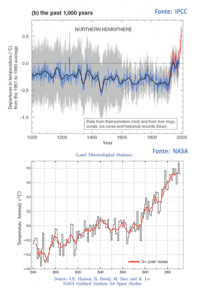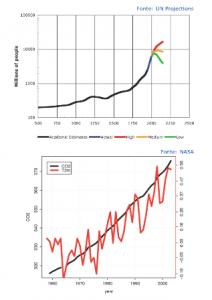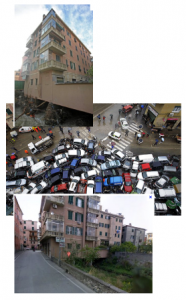The debate about climate change is one of the most enhanced and important in the present times. Is a theme of main impact because involves not only the scientific community but the entire population, triggering a reflection about the relationship between man and nature form the ethic, social and political point of view. Anyway, the belief that man can, even In a small amount, induce a change of the climate conditions must be object of a very careful evaluation based on objective elements by clarifying, and above all, by filtering the enormous amount of available researches and information, that are, most of the time, fruit of subjective analysis biased by the same emotional involvement that feed them.
For climate change are intended the variations on a global level of the values of the Planet Earth main climate and environmental parameters, with a particular emphasis on temperature time series (air and oceans), rainfall, cloudiness and the distribution of the natural elements that characterize the Earth’s crust (water bodies, ice) and the animal and vegetal ecosystem. Those values are to be considered average in both time and space, that is, representative of a determined time frame and a specific territorial context that usually coincide with the globe itself. It is important to note that the considered time and spatial scale have a significant influence on the results produced, especially when the series used are composed not only by direct measurements, but also by indirect reconstruction of climate conditions from the past and the future that are mainly developed by statistic elaborations (figure 1). It’s just the uncertainty of what actually happened in the past and, most of all, of what is going to happen (or may happen) in the future that generates so much interest, allowing the proliferation of so many diverse discussions and conclusions and the consequent born of different “currents of thoughts”. This represents a paradox from the scientific point of view because we can get quite different conclusions from the analysis of the same data and also applying the same hypothesis, notions and methodologies.
Studies of Paleoclimatology, based on indirect evidence of fossils and geological strata, demonstrate the existence in the past of climate and environment changes that have occurred over millions or even hundreds of years, determining ages and glacial and interglacial periods. Among the natural causes of such variations we found external forcing, like the dynamic of the solar activity and the Earth’s orbit and the impact of meteorites, but also Earth’s internal factors like the continental drift, oceanic currents and in the recent centuries also the human factor.
The main effects of climate change due to the anthropisation are the increment of the temperature, the glacier melting, the rising of the oceans and, above all, the greenhouse effect which is judged as the main cause of global warming (in such way that sometimes is used as a synonymous of climate change). The Greenhouse effect is the phenomenon of the increasing of entrapment of the infrared rays by the lower portion of the atmosphere that is essentially linked to the atmospheric gas composition. The main greenhouse gasses are the water vapor, carbon dioxide, methane and ozone whose production is influenced by human and industry activities.
It’s true that the increasing anthropogenic pressure due to the continuous demographic grown (figure 2) determine modifications on an environmental and climate level, but at which space-time scale? That is, what is the real effect of the anthropogenic pressure on the climate? Or even better, what is the value of the relative impact of such modifications in relation with the natural forcing that has always determine the dynamic of climate variation? And, above all, what is the effect of such modifications in relation of the planet’s capacity to self balance and adapt to the changes?
These questions are the subject of thousand of newspaper articles, web sites, blog, and scientific magazines. The debate it’s still alive and growing on, especially in occasion of the numerous summits about climate aimed to find intergovernmental agreements, like the Kyoto protocol, for the reduction of emissions, but it seems increasingly clear how the issue is often resolved in the base of philosophical, political and ethic positions as opposed to the needs of social and economical growth. As a demonstration, just think that is easy to find online a large list of several false myths (https://www.google.it/search?q=climate+change+mith) written by experts and not, where the same discussion item can find diametrically opposed conclusions.
In any case its beyond any doubt that the industrial and technological development that has characterized the last three centuries has surely fueled on one side an unprecedented progress of the social-economic and cultural welfare, but from the other side has also determined an increasing impact of man on nature. Such progress was not, in fact, properly balanced by a regulatory activity by the governments for the control of the dynamics of exploitation of the natural resources. This is particularly important and urgent for the biggest emergent economies of Asia, India and China, that need to treasure and learn from the recent story of the western world.
The last generation engineering technologies and knowledge for the design and monitoring of the territory and the “lesson learned” from the every time most frequent natural catastrophes leave no room for subjective criteria of intervention and to catastrophist positions, invoking climate change, when we are instead unwisely and repeatedly overexploiting the territory without any respect for the natural dynamics and constrains and particularly the hydrogeological and coastal risk (figure 3).
So, beyond the myth and the difficulty in establishing of what is the reality about climate change, is important that such discussion remains at the center of attention as an incentive for governments to furthering economic and social-cultural growth by adopting strict and sensitive policy choices regarding the planning and management of land and coast, the urban, industrial and energy development, and the construction of large civil infrastructure (ports, railways, roads, dams).

 Italiano
Italiano


